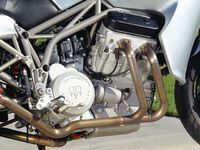Two of the most important technical developments in motorcycling have come to us via the automotive industry: electronic fuel injection (EFI) and anti-lock brakes (ABS). That they arrived first in cars shouldn’t be a surprise if you understand what it must have cost to develop and implement these technologies—on the order of billions, rather than millions, of dollars. It’s an effort that’s probably only possible in an industry of the scale of the auto industry.
When Motus Motorcycles first showed its MST and MST-R sport-touring motorcycles, the MV4 “Baby Block” pushrod V-four engine featured a “milestone” technology in the motorcycle world: gasoline direct injection, or GDI. Direct injection had been seen previously in some two-stroke motorcycles, but that was quite different tech from the four-stroke version on the Motus. GDI applications are proliferating in the four-wheel realm, but the Motus was to be the first bike with GDI.
That’s in past tense because the Motus that will go on sale midway through 2013 will not have GDI. Why the change in course? A brief look at GDI may answer the question.
Using GDI can mean increases in power and torque while reducing emissions and fuel consumption. Injection of fuel directly into the combustion chamber makes possible different strategies adapted to different loads and speeds. For maximum power, a relatively homogeneous mixture of fuel and air can be produced in the chamber, basically mimicking what EFI or even a carburetor can do. For low loads, a “stratified charge” can be created; that’s a rich mixture near the spark plug to ensure ignition while the rest of the chamber remains radically lean. These are only two of several injection modes possible, and it’s even possible to have more than one injection event per intake stroke.
Other benefits: Direct injection of fuel creates more power because the evaporation of the fuel droplets helps reduce intake-charge temperature, which itself is good for power. But this cooling also increases detonation margins, so the engine can use a higher compression ratio without risk of detonation. That’s how you get more power and increased efficiency, and that’s why the auto industry is so hot on the technology.
But it’s not easy. The injection spray is directed and managed by the shape of the combustion chamber, piston crown, and the proximity of the cylinder walls. To give a sense of how important these design features can be in GDI, the new Corvette’s LT1 direct-injection engine saw 6 million computer-processing hours spent on combustion-chamber design alone, investigating more than 75 different configurations.
Because the duration of injection events with GDI can be just a fraction of that of EFI, the technology requires very high fuel pressure and an extra fuel pump. The reduced time for injection, and the necessity to switch between injection modes depending on engine loads and speeds, requires electronic control hardware specific to GDI applications. Basically, there is little if any carryover hardware from a port-injection system to GDI.
When it was announced in the spring of 2012 that the Motus production bike would not be fitted with GDI, Motus President Lee Conn said, “... we concluded that there is not enough support in the current (motorcycle) industry to roll out this technology yet.”
Conn pointed to the Motus company goal of providing a bike that would allow owners to modify their machines. While EFI is now an open book to the motorcycle aftermarket, GDI is not. Once tuners begin to work with GDI they’ll be quick to learn, but there’s no hands-on experience yet. From this angle, the Motus position makes sense.
As an indication of hardware costs, it’s telling that Bosch Motronic, a direct injection supplier, estimated in 2011 that about 13 percent of new cars worldwide had GDI, and forecast a 28 percent share in 2015. That tells us that economies of scale have certainly not fully kicked in yet, and that early users are still paying a premium for the technology.
Credit Motus for taking a shot and proving that GDI will be with us soon—just maybe not as soon as we thought.












/cloudfront-us-east-1.images.arcpublishing.com/octane/S35YGSEMEZB4BLTDJTSZPF4GLA.jpg)
/cloudfront-us-east-1.images.arcpublishing.com/octane/5UOT6HPX2JFMRJAX6EH45AR4MQ.jpg)
/cloudfront-us-east-1.images.arcpublishing.com/octane/OKWOJWAKP5EP3OACCRRWPCIX2Q.jpg)
/cloudfront-us-east-1.images.arcpublishing.com/octane/2WF3SCE3NFBQXLDNJM7KMXA45E.jpg)
/cloudfront-us-east-1.images.arcpublishing.com/octane/G4MG6OUCJNBSHIS2MVVOTPX65E.jpg)
/cloudfront-us-east-1.images.arcpublishing.com/octane/IIGGWFOTOJGB7DB6DGBXCCMTDY.jpg)
/cloudfront-us-east-1.images.arcpublishing.com/octane/QSTCM6AVEZA5JJBUXNIQ3DSOF4.jpg)
/cloudfront-us-east-1.images.arcpublishing.com/octane/U4I7G625B5DMLF2DVIJDFZVV6M.jpg)
/cloudfront-us-east-1.images.arcpublishing.com/octane/B6XD6LS6IVCQPIU6HXDJSM3FHY.jpg)
/cloudfront-us-east-1.images.arcpublishing.com/octane/ICL63FEDDRDTTMINYICCEYGMDA.jpg)
/cloudfront-us-east-1.images.arcpublishing.com/octane/FCGZHQXRBZFLBAPC5SDIQLVF4I.jpg)
/cloudfront-us-east-1.images.arcpublishing.com/octane/WNOB6LDOIFFHJKPSVIWDYUGOPM.jpg)

/cloudfront-us-east-1.images.arcpublishing.com/octane/X33NU3E525ECRHXLNUJN2FTRKI.jpg)
/cloudfront-us-east-1.images.arcpublishing.com/octane/6KKT5NNL2JAVBOXMZYS5ZO76YA.jpg)
/cloudfront-us-east-1.images.arcpublishing.com/octane/J5RKG5O455GMPGQRF2OG6LRT7A.jpg)
/cloudfront-us-east-1.images.arcpublishing.com/octane/GX2CIZKQVRH2TATDM26KFG2DAE.jpg)
/cloudfront-us-east-1.images.arcpublishing.com/octane/ZWIDYSAKQZHD5BHREMQILXJCGM.jpg)
/cloudfront-us-east-1.images.arcpublishing.com/octane/CYUHJZCTSJCH3MRAQEIKXK7SCQ.jpg)
/cloudfront-us-east-1.images.arcpublishing.com/octane/LKOFINY56FCXJCANJ5M7ZDQUBY.jpg)
/cloudfront-us-east-1.images.arcpublishing.com/octane/4NBPDACMWJH63JQYJVK3QRBDZI.jpg)
/cloudfront-us-east-1.images.arcpublishing.com/octane/KKHQHRR3FJGX7H2IPU6RALMWG4.jpg)

/cloudfront-us-east-1.images.arcpublishing.com/octane/5IOFS5JAE5FOXMNA23ZRAVVYUU.jpg)